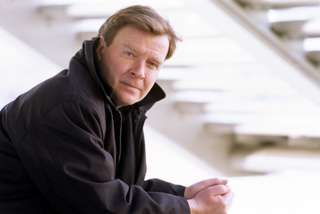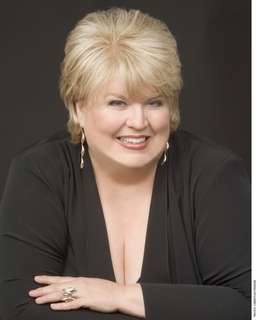|
Back
Magnus Lindberg’s Time And Space New York
Alice Tully Hall, LIncoln Center Complex
06/23/2010 - & June 24, 26, 2010
Magnus Lindberg: Al Largo (World premiere)
Ludwig van Beethoven: Missa Solemnis, Opus 123
Christine Brewer (Soprano), Jane Henschel (Mezzo-Soprano), Anthony Dean Griffey (Tenor), Eric Owens (Bass-Baritone)
New York Choral Artists, Joseph Flummerfelt (Director), New York Philharmonic Orchestra, Alan Gilbert (Conductor)

M. Lindberg (© Hanya Chlala/Arena PAL)
Brahms famously feared the ghost of Beethoven breathing behind him. Magnus Lindberg, though, is fearless. Not only does he use (what he calls) “a Beethoven-sized orchestra”, but the Philharmonic’s composer-in-residence last night took the lead, placing himself in front of Ludwig, courageously offering the world premiere of Al Largo for the full, surprisingly appreciative audience.
I say surprisingly, because Avery Fisher audiences aren’t terribly fond of music that could be called contemporary. But Mr. Lindberg created, in 25 minutes, a tapestry which surged and flowed with such brilliant orchestral colors, and such an intriguing structure that its alleged “modernism” was no barricade.
The only puzzle might have been the title. Initially, I had thought the neologistic Al Largo was a play on words for two tempos: Allegro and Largo. But while this would have fit (since Mr. Lindberg explained that it did indeed have very fast movements with a slow underpinning), the words Al Largo, here mean “offshore”, or, more poetically, an Italian phrase for the period when a ship loses sight of land.
In fact, the music was oceanic in many ways, perhaps even akin to Debussy’s La Mer. From the start, it was filled with fanfares, surging buzzings of the strings, or sparkling cadenzas by the oboes and other winds. I tried at first to find thematic connections, orchestral reflections. But this occupied what should have been an ingenuous audio reaction. After five minutes, in fact, I let my ears do the thinking, leaving more noetic hearings for another day.
That was a wise choice, for the two connected movements were blazing. Mr. Lindberg explained that he wanted a “small orchestra”, and while that probably makes sense on the score, the music was almost uniformly loud and sometimes gloriously loud.
Mr. Lindberg can’t help himself. The cascades of notes turned into trombone flourishes, the complex woodwind figurations were transformed into fortissimo celebrations
Yet beneath it all were the strings, usually subdued but always whizzing away, even in the most stentorian orchestral sections, offering two different emotional tempos as one.
I mentioned La Mer before, and thinking about it now, the affinity seems even more close. For just as Debussy was trying to show the interplay of wind and waves, Mr. Lindberg showed an interplay of the orchestra which created its own unique tempo. The fact that he ended with those few last notes of Schoenberg’s Verklärte Nacht was his own musical reference–as he inferred, the cusp between tonal and atonal. But Mr. Lindberg himself bridges those two in all his compositions. I found Al Largo, in its exploration of space and time, one of his most substantial.

C. Brewer (© Christian Steiner)
The Beethoven Mass in D (a.k.a Missa Solemnis) was hardly an aftermath to Mr. Lindberg. But its undeniable choral grandeur at times is a much of a muchness. It is loud, completely choral (the four soloists sing as an ensemble), written for immediately brilliant grandeur. One must wonder how the Beethoven who created the last string quartets and piano sonatas–haunting, puzzling, pre-Freudian see-saws of hysteria and death-like solemnity–could have written this Mass. But he was Beethoven, so one cannot doubt its exterior nobility.
As this season comes to an end, I am more and more entranced by Mr. Gilbert’s command of all his forces, and he hardly disappointed here. The New York Choral Artists were right on target, their staccato calls as sharp as their Agnus Dei passages were elegant. The four soloists, singing in canon or fugue or together, were led by Christine Brewer, the most radiant soprano for this occasion, but the quartet blended always well.
Yet the praises must go to Mr. Gilbert’s orchestra. After so much choral music, the orchestral interludes–especially Glenn Dicterow’s work in the prelude to the Benedictus–distracted from the ecclesiastical singing with breaths of fresh air.
*************************************************
CODA: The Italian movie Io sono l’amore (“I Am Love”) is a uniquely haunting drama. Without going into the details, much is helped by the music of John Adams. Not original music (Adams has never written for films), but excerpts, which are placed in portions for which the composer never intended. It starts with snowy Milan (and music from The Chairman Dances), ending with the last movement of Harmonielehre. It also includes Century Rolls, Fearful Symmetries, Light over Water, Shaker Loops, Lollapalooza and the Desert Chorus from The Death of Klinghoffer.
For the record, Mr. Adams was ambiguous about his reaction, though praising the film overall. Readers here are urged to see the movie and make their own comments.
Harry Rolnick
|